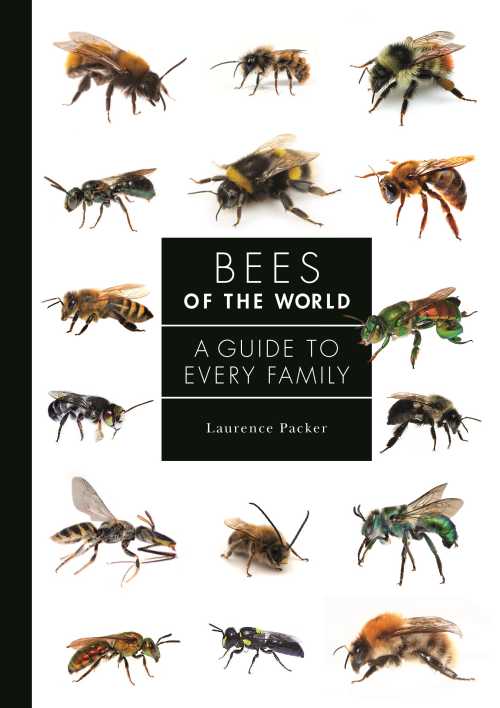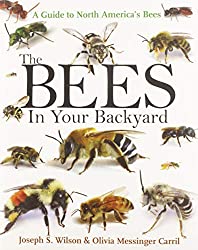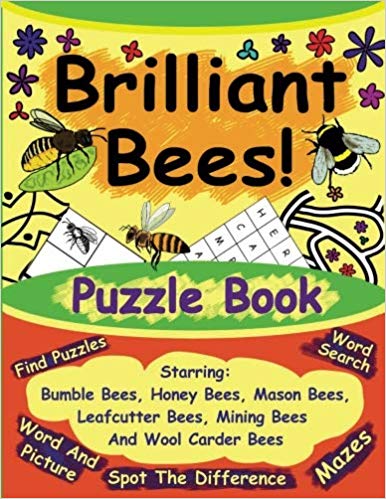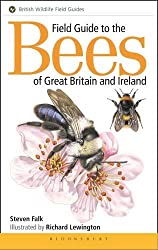Megachilidae Bee Family
The Megachilidae bee family is a diverse family of bees with over 4000 species described worldwide1,2,3 organized into 4 subfamilies4 and around 76 genera3.
Many species within this bee family are well recognized for their value as pollinators of agricultural crops, especially alfalfa, as well as fruit crops such as blueberry.
All Megachilid bees belong within the long-tongued category.
A variety of nesting habits are found in this group. Some will construct sites in snail shells, others in hollow stems and crevices whilst others, for example the Coelioxys - Sharp-tail bees, are cleptoparasites which seek out the nests of other species, where they deposit their eggs.
USA and Canada
According to Wilson & Messinger Carril - The Bees In Your Backyard3, in the USA and Canada specifically, there are 18 genera can be found that belong to the Megachilidae family, comprising over 600 species.
UK
In the UK, there are 40 Megachilidae species belonging to 8 genera (Falk 20152).
Subfamilies Of The Megachilidae Bee Family
The 4 subfamilies, within this group are:
Megachilinae
The largest subfamily within the group, on its own having over 4,000 described species4.
Fideliinae
Includes 19 species of ground-nesting bees found in Chile and southern Africa, 1 each in Peru and Morocco4.
Pararhophitinae
Comprises a single genus with 3 bee species found in a region extending from Morocco to northwestern India4.
Lithurginae
Has 5 genera and 64 species4.
Example Genera Within This Family
Anthidium - Wool carders
The wool carders are stocky bees, with the habit of carding wool, typically from hairy plant stems such as Stachys byzantina (Lamb's ear) which are then used in nest construction.
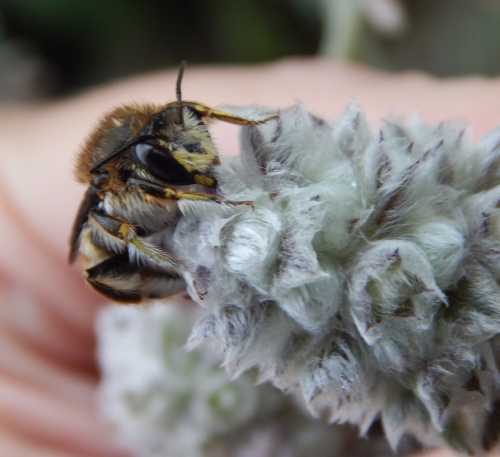 Anthidium manicatum
Anthidium manicatumDue to the yellow and black markings on the abdomen, this species can be confused with wasps. In this species, males are larger than females. Males are also territorial, guarding patches of flowers as they look out for potential mates.
Anthidium collect pollen on the underside of their abdomens.
There are 160 known species worldwide, 36 in the US and Canada, and 1 species in Britain.
Stelis - Dark bees
Also belonging to this bee family are Stelis bees.
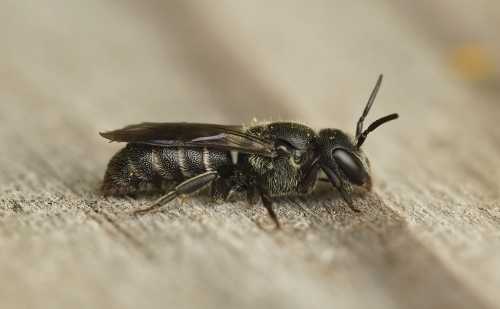 Little Dark Bee - Stelis breviuscula female
Little Dark Bee - Stelis breviuscula femaleStelis species are cleptoparasites of other Megachilid bees, including Anthidium, Osmia, Heriades and others.
Females of this species may lay multiple eggs in a host nest burrow, returning repeatedly to the nest to lay a single egg in each newly constructed egg cell.
There are 51 species in the US and Canada, Britain has 4 species.
Heriades - Resin bees
These small, dark bees are found in Europe, Asia, India, Japan, parts of Africa, and the Pacific Islands. Canada has 4 species, North and Central America have about 25 species.
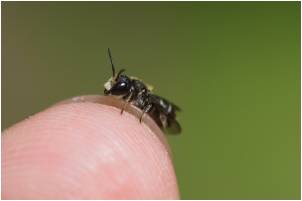 Heriades truncorum
Heriades truncorumTwo Resin bee species are found in Britain.
Megachile - Leafcutter bees
'Megachile' means 'large lipped' although Wilson & Messinger Carril note that the name may refer to the large jaws of these species.
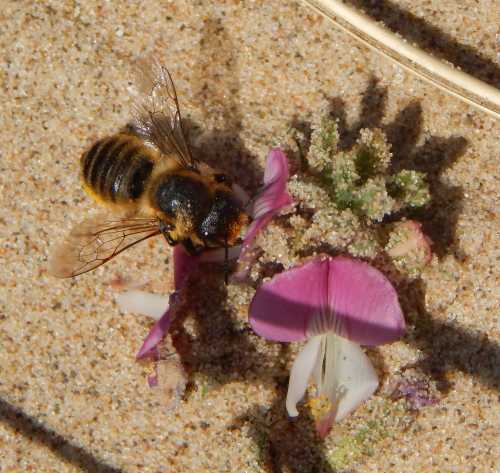 Megachile maritima
Megachile maritimaMany species use their jaws to cut segments of leaf or flower petals with which to line and construct nest cells. Nests are typically found in hollow canes and crevices. Some species nest in the ground.
This species is particularly important in the pollination of alfalfa crops, and is a popular group in gardens where it may nest in bee houses.
Included in this group is the world's largest known bee, Megachile pluto - Wallace's giant bee.
There are over 140 leafcutter species in America and Canada, Britain has 10 species.
They collect pollen on a brush underneath the abdomen, and typically vibrate the abdomen whilst loosening the pollen from the flower anthers.
Chelostoma - Scissor bees
These are dark, slender bees. There are about 60 Chelostoma species worldwide. They nest in pre-existing holes and cavities, often in wood but also in masonry.
Pollen is collected on a pollen brush under the abdomen. The US and Canada have about 10 species.
Britain has 2 Chelostoma species.
Coelioxys - Sharp-tail bees
These are cleptoparasitic species, targeting Megachile and Anthophora species. They are unusual, in that like honey bees, they have hairy eyes.
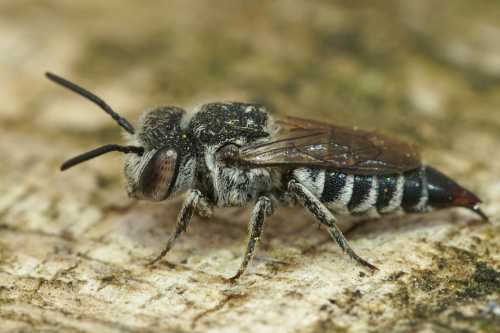 Sharp-bellied bee, Coelioxys acanthura
Sharp-bellied bee, Coelioxys acanthuraThe females use their pointed abdomens to cut a slit in the partition of a target host nest cell, then deposit an egg inside. The emerging grub has powerful jaws which it uses to kill the offspring of the host.
There are 8 species in Britain and about 45 species in the US, 10 in Canada.
Osmia - Mason bees
Another important pollinator of agricultural crops, species within the mason bee group are increasingly reared for the provision of pollination services, especially of fruits.
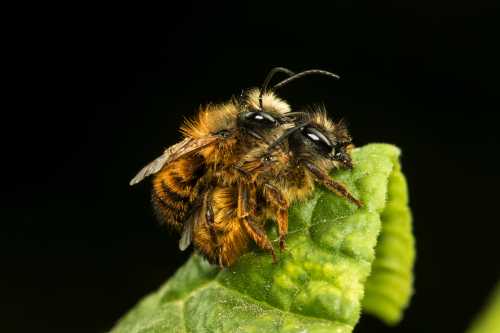 Osmia rufa mating
Osmia rufa matingThese species have comparatively large, box-shaped heads and strong jaws for chewing leaf and mud mastic for nest construction. Nests may occur in masonry and rock crevices, as well as in hollow stems, bee houses, or even snail shells.
Britain has 12 known species, US and Canada have over 130 species.
Hoplitis - Lesser mason bees
A wide-ranging, diverse group of bees, some of which are metallic in hue. There are almost 6o species in the US and Canada. Only 2 species have ever been recorded in Britain.
Bees Of The World - Book Review
References
1. Bees of The World: A Guide To Every Family, Laurence Packer. Princeton University Press, Princeton & Oxford, 2023; ISBN: 798-0-691-22662-0.
2. Field Guide to Bees Of Great Britain And Ireland by Steven Falk, Bloomsbury 2015.
3. Wilson & Messinger-Carril; The Bees In Your Backyard, Princeton University Press 2016.
4. Bees of The World: A Guide To Every Family, Laurence Packer. Princeton University Press, Princeton & Oxford, 2023; ISBN: 798-0-691-22662-0.
If you found this page helpful or interesting, I'd really be grateful if you would share it with others - if not this page, perhaps another, such as Gardening For Bees.
Thank you so much :) .
